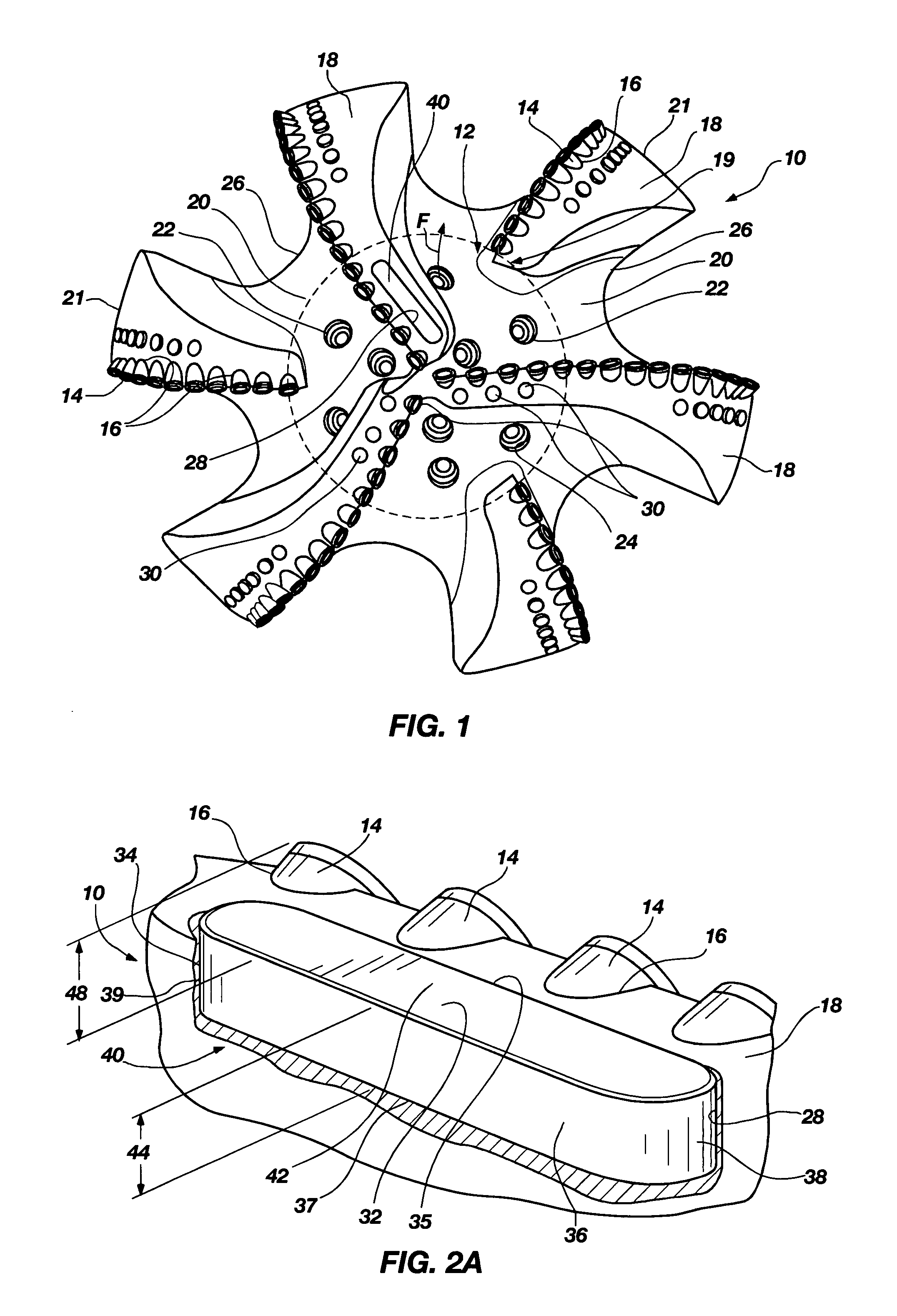Interchangeable bearing blocks for drill bits, and drill bits including same
a technology of bearing blocks and drill bits, which is applied in the direction of drilling rods, drilling pipes, cutting machines, etc., can solve the problems of pdc cutters still suffering from what might simply be termed “overloading, excessive bit aggressiveness, and the like, and achieves the reduction of the required inventory count of bits, the reduction of manufacturing tolerance uncertainty, and the reduction of the complexity of obtaining a tdoc
- Summary
- Abstract
- Description
- Claims
- Application Information
AI Technical Summary
Benefits of technology
Problems solved by technology
Method used
Image
Examples
first embodiment
[0041]the invention is shown in FIGS. 1, 2A, 3A and 4. FIG. 1 shows a steel body drag bit 10 having an attached bearing block 40 as viewed by looking upwardly at its face or leading end 12 as if the viewer was positioned at the bottom of a borehole. Bit 10 includes a plurality of PDC cutters 14 bonded by their substrates (diamond tables and substrates not shown separately for clarity), as by brazing, into pockets 16 in blades 18 extending above the face 12 of the bit 10, as is known in the art with respect to the fabrication of steel body bits. Alternatively, the bit 10 may also be a so-called “matrix” type bit. Such bits include a mass of metal powder, such as tungsten carbide, infiltrated with a molten, subsequently hardenable binder, such as a copper-based alloy, for example the bit frame 110 shown in FIG. 5 as discussed below. It should be understood, however, that the invention is not limited to steel body or matrix-type bits, and bits of other manufacture may also be configure...
seventh embodiment
[0054]Interchangeable bearing blocks in accordance with a fifth, sixth and seventh embodiment of the invention are now presented. Generally, before turning specifically to the embodiments that follow, the bearing blocks of the invention may also include one or more cutter pockets. Each cutter pocket is in addition to the bearing block having a designed thickness and / or a designed rubbing area. Each cutter pocket added to the bearing block enables a target depth of cut (TDOC) for the cutters mounted in that block to be determined with respect to the block, instead of being determined conventionally with respect to the blade of a bit body as is known in the art. Also, each bearing block, as described in the embodiments that follow, may be configured to complete the radially inner end of a given blade portion and is located substantially in the cone region, the cone-nose region or the nose region of the bit frame. As mentioned above, bearing blocks having different thicknesses and diff...
fifth embodiment
[0056]FIG. 5 shows a bit frame 110 for a matrix body PDC bit, the bit frame 110 including attached cone blade bearing blocks 112, 114 in accordance with the invention. Simultaneous reference may also be made to FIGS. 6 and 7 to further describe embodiments of the invention. The bit frame 110 as depicted in FIG. 5 includes four blades 116, 117, 118, 119, and further includes a plurality of nozzle ports 120, a plurality of cutter pockets 122 and a plurality of insert pockets 124. The blades 116, 118 each include blade pockets 126, 128, respectively (blade pocket 128 shown also in FIG. 6). It is recognized that there may be any suitable number of blades or blade pockets on a given bit frame and are not necessarily limited to four blades 116, 117, 118, 119 and two blade pockets 126, 128, respectively. It is anticipated, although not necessarily required, that the bit frame may be standardized to include a blade pocket on each blade that extends radially inwardly significantly into the c...
PUM
 Login to View More
Login to View More Abstract
Description
Claims
Application Information
 Login to View More
Login to View More - R&D
- Intellectual Property
- Life Sciences
- Materials
- Tech Scout
- Unparalleled Data Quality
- Higher Quality Content
- 60% Fewer Hallucinations
Browse by: Latest US Patents, China's latest patents, Technical Efficacy Thesaurus, Application Domain, Technology Topic, Popular Technical Reports.
© 2025 PatSnap. All rights reserved.Legal|Privacy policy|Modern Slavery Act Transparency Statement|Sitemap|About US| Contact US: help@patsnap.com



